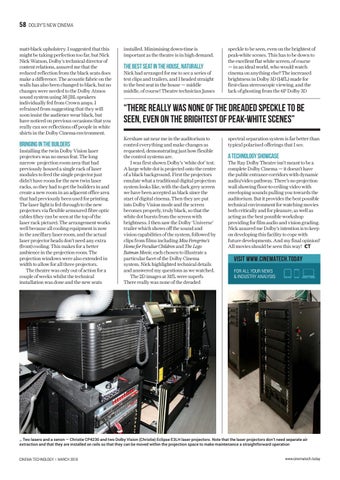58
DOLBY’S NEW CINEMA
matt-black upholstery. I suggested that this might be taking perfection too far, but Nick Nick Watson, Dolby’s technical director of content relations, assured me that the reduced reflection from the black seats does make a difference. The acoustic fabric on the walls has also been changed to black, but no changes were needed to the Dolby Atmos sound system using 38 JBL speakers individually fed from Crown amps. I refrained from suggesting that they will soon insist the audience wear black, but have noticed on previous occasions that you really can see reflections off people in white shirts in the Dolby Cinema environment.
Bringing in the builders Installing the twin Dolby Vision laser projectors was no mean feat. The long narrow projection room area that had previously housed a single rack of laser modules to feed the single projector just didn’t have room for the new twin laser racks, so they had to get the builders in and create a new room in an adjacent office area that had previously been used for printing. The laser light is fed through to the new projectors via flexible armoured fibre optic cables (they can be seen at the top of the laser rack picture). The arrangement works well because all cooling equipment is now in the ancillary laser room, and the actual laser projector heads don’t need any extra (front) cooling. This makes for a better ambience in the projection room. The projection windows were also extended in width to allow for all three projectors. The theatre was only out of action for a couple of weeks whilst the technical installation was done and the new seats
installed. Minimising down-time is important as the theatre is in high demand.
The best seat in the house, naturally Nick had arranged for me to see a series of test clips and trailers, and I headed straight to the best seat in the house — middle middle, of course! Theatre technician James
speckle to be seen, even on the brightest of peak-white scenes. This has to be down to the excellent flat white screen, of course — in an ideal world, who would watch cinema on anything else? The increased brightness in Dolby 3D (14fL) made for first-class stereoscopic viewing, and the lack of ghosting from the 6P Dolby 3D
“THERE REALLY WAS NONE OF THE DREADED SPECKLE TO BE SEEN, EVEN ON THE BRIGHTEST OF PEAK-WHITE SCENES” Kershaw sat near me in the auditorium to control everything and make changes as requested, demonstrating just how flexible the control systems are. I was first shown Dolby’s ‘white dot’ test. A large white dot is projected onto the centre of a black background. First the projectors emulate what a traditional digital projection system looks like, with the dark grey screen we have been accepted as black since the start of digital cinema. Then they are put into Dolby Vision mode and the screen becomes properly, truly black, so that the white dot bursts from the screen with brightness. I then saw the Dolby ‘Universe’ trailer which shows off the sound and vision capabilities of the system, followed by clips from films including Miss Peregrine’s Home for Peculiar Children and The Lego Batman Movie, each chosen to illustrate a particular facet of the Dolby Cinema system. Nick highlighted technical details and answered my questions as we watched. The 2D images at 31fL were superb. There really was none of the dreaded
spectral separation system is far better than typical polarised offerings that I see.
A technology showcase The Ray Dolby Theatre isn’t meant to be a complete Dolby Cinema — it doesn’t have the public entrance corridors with dynamic audio/video pathway. There’s no projection wall showing floor-to-ceiling video with enveloping sounds pulling you towards the auditorium. But it provides the best possible technical environment for watching movies both critically and for pleasure, as well as acting as the best possible workshop providing for film audio and vision grading. Nick assured me Dolby’s intention is to keep on developing this facility to cope with future developments. And my final opinion? All movies should be seen this way!
visit www.cinematech.today FOR ALL YOUR NEWS & INDUSTRY ANALYSIS
Two lasers and a xenon — Christie CP4230 and two Dolby Vision (Christie) Eclipse E3LH laser projectors. Note that the laser projectors don’t need separate air extraction and that they are installed on rails so that they can be moved within the projection space to make maintenance a straightforward operation CINEMA TECHNOLOGY | MARCH 2018
www.cinematech.today
